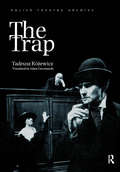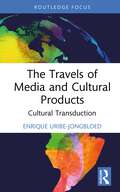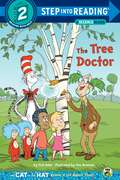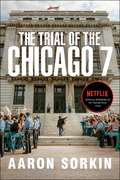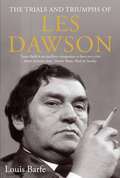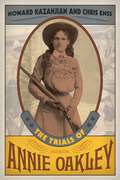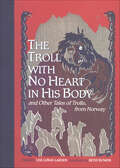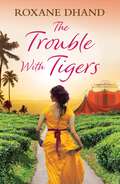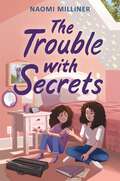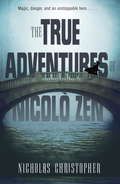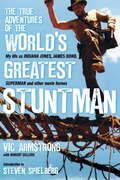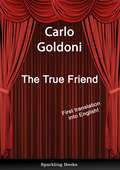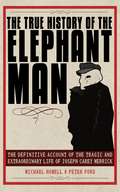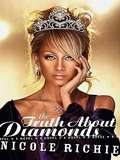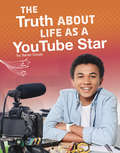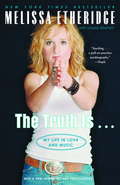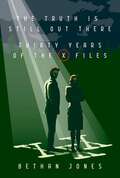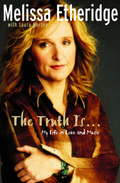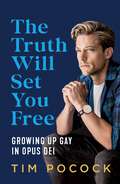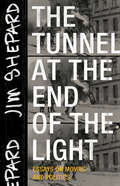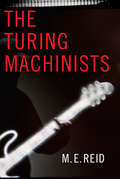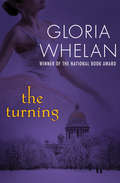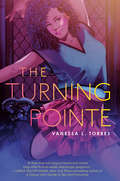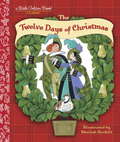- Table View
- List View
The Trap
by Tadeusz RosewiczFirst Published in 1998. Routledge is an imprint of Taylor & Francis, an informa company.
The Travels of Media and Cultural Products: Cultural Transduction (Routledge Studies in Media and Cultural Industries)
by Enrique Uribe-JongbloedThis book presents the Cultural Transduction framework as a conceptual tool to understand the processes that media and cultural products undergo when they cross cultural and national borders. Using a series of examples from pop culture, including films, television series, video games, memes and other digital products, this book provides the reader with a wider understanding of the procedures, interests, roles, assumptions and challenges, which foster or hinder the travels of media and cultural products. Compiling in one single narrative a series of case studies, theoretical debates and international examples, the book looks at a number of exchanges and transformations enabled by both traditional media trade and the internet. It reflects on the increase of cultural products crossing over regional, national and international borders in the form of video games and TV formats, through music and video distribution platforms or via digital social media networks, to highlight discussions about the characteristics of border-crossing digital production. The cultural transduction framework is developed from discussions in communication and media studies, as well as from debates in adaptation and translation studies, to map out the travels of media and cultural products from an interdisciplinary perspective. It provides a tool to analyse the markets, products, people and processes that enable or constrain the movement of products across borders, for those interested in the practical aspects that underlie the negotiation and transformation of products inserted into different cultural market settings. This volume provides a new framework for understanding the travels of cultural products, which will be of use to students and scholars in the area of media industry studies, business studies, digital media studies, international media law and economics.
The Tree Doctor (Step into Reading)
by Tom Brannon Tish RabeWhen Sally and Nick's maple tree won't grow, the Cat in the Hat knows who to call: Dr. Twiggles, who suggests they inspect its roots. A trip underground in the Thinga-ma-jigger is undertaken, and sure enough, the maple tree needs water (which Things One and Two procure in ridiculous overabundance) and sun (which the Cat supplements with a Brighta-ma-lighter). But as for getting syrup from the young sapling? That will take some 40 years! Written specifically for children learning how to read with help, this Step into Reading book is based on an episode of the hit PBS Kids' TV show The Cat in the Hat Knows a Lot About That! It is perfect for springtime reading, Earth and Arbor Day celebrations--and yes, even pancake breakfasts!
The Trial of the Chicago 7: The Screenplay
by Aaron SorkinThe brilliant screenplay of the forthcoming film The Trial of the Chicago 7 by Academy and Emmy Award–winning screenwriter and director Aaron Sorkin.Sorkin&’s film dramatizes the 1969 trial of seven prominent anti-Vietnam War activists in Chicago. Originally there were eight defendants, but one, Bobby Seale, was severed from the trial by Judge Julius Hoffman—after Hoffman had ordered Seale bound and gagged in court. The defendants were a mix of counterculture revolutionaries such as Abbie Hoffman and Jerry Rubin, and political activists such as Tom Hayden, Rennie Davis, and David Dellinger, the last a longtime pacifist who was a generation older than the others. Their lawyers argued that the right to free speech was on trial, whether that speech concerned lifestyles or politics. The Trial of the Chicago 7 stars Sacha Baron Cohen, Eddie Redmayne, Frank Langella, and Mark Rylance, among others, directed by Aaron Sorkin. This book is Sorkin&’s screenplay, the first of his movie screenplays ever published.
The Trials and Triumphs of Les Dawson
by Louis BarfeThe first ever narrative biography of a towering figure in British comedy Les Dawson, more than any other comedian, spoke for the phlegmatic, pessimistic British way of life. A Northern lad who climbed out of the slums thanks to an uncommonly brilliant mind, he was always the underdog, but his bark was funnier and more incisive than many comics who claimed to bite. Married twice in real life, he had a third wife in his comic world—a fictional ogre built from spare parts left by fleeing Nazis at the end of World War II—and an equally frightening mother-in-law. He was down to earth, yet given to eloquent, absurd flights of fancy. He was endlessly generous with his time, but slow to buy a round of drinks. He was a mass of contradictions. In short, he was human, he was genuine, and that's why audiences loved him. This is his story.
The Trials of Annie Oakley
by Chris Enss Howard KazanjianLong before the silver screen showed the face of Mary Pickford to millions of Americans, Annie Oakley, born as Phoebe Anne Oakley Moses on August 13, 1860, had won the right to the title of &“America&’s Sweetheart.&” Having grown up learning to shoot game to help support her family, Annie won first prize and met Frank Butler at a shooting match when she was fifteen years old. He convinced her to change her name to Annie Oakley and became her husband, manager, and number-one fan for the next fifty years.Annie quickly gained worldwide fame as an incredible crack shot, and could amaze audiences at her uncanny accuracy with nearly any rifle or pistol, whether aiming at stationary objects or shooting fast-flying targets from the cockpit of a moving airplane. In August 1903, when she was well known as a champion shot in Buffalo Bill&’s Wild West Show, Oakley became a target of defamation by a reporter for a newspaper owned by media magnate William Randolph Hearst. The libelous story alleged that the famous sure shot had been arrested for stealing and buying drugs. Annie sent a telegram denying the claim and asked the story to be retracted. Hearst refused and the story was then published in all his newspapers. Miss Oakley responded with a libel suit and spent seven years in court fighting the well-known businessman. During the long, drawn-out legal battle, Annie was struggling with health issues. Despite these trials she poured her energy into advocating for the US military, encouraging women to engage in sport shooting, and supporting orphans.
The Troll with No Heart in His Body: And Other Tales of Trolls, from Norway
by Lise Lunge-LarsenAs tall as trees and as ancient and rugged as the Norwegian landscape from which they come, trolls are some of lore's most fascinating and varied creatures. Some live under bridges, others deep inside caves. They can carry their heads under their arms or hide their hearts inside wells. They can walk across oceans and fly over mountains. Trees and shrubs may grow from their heads, and their noses can be long enough to stir soup. There are troll hags, troll daughters, and elderly, shrunken trolls. Old or young, they are quarrelsome, ugly, and boastful, and they love to trick princesses and children. To defeat them, children must rely on the strengths of their humanity-persistence, kindness, pluck, and willingness to heed good advice
The Trouble With Tigers: Take a trip to 20th Century India in this gripping historical read full of romance and adventure
by Roxane DhandFrom the best-selling author of The Pearler's Wife, a gripping and immersive story of family secrets, sacrifice and romance set against the backdrop of a spell-binding circus in 20th Century India. Perfect for fans of books by Lucinda Riley and Dinah Jeffries.After her father died under mysterious circumstances, Lilly Myerson grew up in England raised by her grandparents. Married off at eighteen to a well-to-do but controlling Indian merchant, Lilly has never experienced adventure or romance.But in 1902 as a new king is about to be crowned, Lilly's life is destined to change.When her estranged mother invites her to spend the hot season in Nainital, Lilly's husband forces her to leave her beloved, five-year-old son Teddy behind. As Lilly discovers what lies outside her sheltered existence, she realises two things: she can't return to her carefully manicured life and she must rescue Teddy before his father turns him against her.Fleeing to the circus, Lilly enters a breath-taking world of wonder, romance and peril. Tiffert's Circus is renowned for bareback riding, the iron jaw act, trained tigers and elephants. The more dangerous the acts, the more the audience adore them. But the greater danger to Lilly Myerson is her husband Royce...
The Trouble With Tigers: Take a trip to 20th Century India in this gripping historical read full of romance and adventure
by Roxane DhandFrom the best-selling author of The Pearler's Wife, a gripping and immersive story of family secrets, sacrifice and romance set against the backdrop of a spell-binding circus in 20th Century India. Perfect for fans of books by Lucinda Riley and Dinah Jeffries.After her father died under mysterious circumstances, Lilly Myerson grew up in England raised by her grandparents. Married off at eighteen to a well-to-do but controlling Indian merchant, Lilly has never experienced adventure or romance.But in 1902 as a new king is about to be crowned, Lilly's life is destined to change.When her estranged mother invites her to spend the hot season in Nainital, Lilly's husband forces her to leave her beloved, five-year-old son Teddy behind. As Lilly discovers what lies outside her sheltered existence, she realises two things: she can't return to her carefully manicured life and she must rescue Teddy before his father turns him against her.Fleeing to the circus, Lilly enters a breath-taking world of wonder, romance and peril. Tiffert's Circus is renowned for bareback riding, the iron jaw act, trained tigers and elephants. The more dangerous the acts, the more the audience adore them. But the greater danger to Lilly Myerson is her husband Royce...
The Trouble with Secrets
by Naomi MillinerA Jewish girl preparing for her upcoming bat mitzvah tries to keep a secret—along with one of her sister’s—in this beautiful coming-of-age contemporary novel that explores change, grief, and the complexities of sibling relationships.Twelve-year-old Becky has great expectations placed upon her. Not only does she need to be as perfect as her older brother and sister, but her upcoming bat mitzvah needs to be perfect, too. She is the rabbi’s daughter, after all. The trouble is, Becky’s intentions often lead her astray. At least when she plays the flute, she feels like the best version of herself. Until playing the flute causes Becky to do something not so perfect: keep a secret from her parents.Then Becky discovers that Sara, her "perfect" sister, has an even bigger secret. One that could turn the family upside down. The sisters couldn’t be more ready to keep each other’s secret safe…until the excitement turns to guilt, and Becky is forced to make an impossible choice.When secrets are shared and choices are made, doing the right thing can feel so wrong. And Becky will learn that actions, no matter how well intended, always have consequences.
The True Adventures of Nicolo Zen
by Nicholas ChristopherThis richly-detailed historical novel from master storyteller Nicholas Christopher features an unforgettable hero: Nicolo Zen is all alone in 1700s Venice, save for his clarinet, which a mysterious magician had magicked, allowing its first player to perform expertly. Soon Nicolo is a famous virtuoso, wealthy beyond his dreams. But he can't stop wondering if he earned the success or if it's due to the magician's spell. So he has the spell removed to test his own talents and capabilities. And throughout it all, he continues to think about the girl he met in Venice, what she might be doing and if she's safe from harm. With a guest appearance by composer Vivaldi, and brimming with fascinating period details, this is a compelling coming-of-age story full of universal themes teens will instantly recognize. The love story will conjure memories of Romeo and Juliet, perfect for teens who love stories set in other times, but without a paranormal storyline (as long as you don't count a magician who dresses all in white and can be in two places on once . . . ).
The True Adventures of the World's Greatest Stuntman: My Life as Indiana Jones, James Bond, Superman and Other Movie Heroes
by Vic ArmstrongThink you don't know Vic Armstrong? Wrong! You've seen his work in countless films... He's been a stunt double for James Bond, Indiana Jones and Superman, and he's directed action scenes for three Bond movies, Mission Impossible 3, Thor, and the upcoming The Amazing Spider-Man to name but a few. Counting Harrison Ford, Steven Spielberg and Arnold Schwarzenegger among his friends, and officially credited in the Guinness Book of World Records as the World's Most Prolific Stuntman, Vic's got a lot of amazing stories to tell, and they're all here in this - the movie memoir of the year!
The True Friend: English translation of Il vero amico
by Carlo GoldoniTrue to Goldoni's mixture of comic wit and farce, the plot is a breathtakingly fast succession of twists and turns which only unravel in the final lines with a surprise ending.Two friends are in love with the same young woman. Neither wants to place their friendship in jeopardy. How can love triumph without breaking off their friendship? Goldoni explores the conflicts brought about when Florindo has to choose between Lelio, his best friend, and Rosaura, his friend's fiancée. Added to this conundrum are the issues of whether Ottavio, the old miser, will provide a dowry and the mature Beatrice's unashamed incessant pursuit of Florindo.The play is set in Bologna in Lelio's house. Florindo is a guest along with his faithful manservant. From the opening of the play, Florindo seeks to return home to Venice in order not to damage his friend's relationship. However, his departure is obstructed by his hosts, leading to one complication after another.From the beginning, the plot is intense and fast-moving with inversions fed into the action in quick succession. This creates suspense which continues throughout the play as potential marriage partners are switched back and forth until the very ending when the audience finally discovers what the main characters' destiny will be. Will love or friendship prevail?The Venetian element is brought into this play through Florindo and his manservant, both Venetians. Apart from these two characters, all the others are portrayed as self-seeking, selfish and sly - whether servants or masters. The tension is kept at a constantly high level by the struggles between the characters. These struggles are not just brought about through love and friendship but are also generational and social. Furthermore, there is the added complication in the contrast of the characters' ideas of reality as they deceive one another. This creates dramatic irony and humour as the audience know more than any of the characters on stage.
The True History of the Elephant Man: The Definitive Account of the Tragic and Extraordinary Life of Joseph Carey Merrick
by Peter Ford Michael HowellDue to horrible physical deformities, he spent much of his life as a fair-ground freak. He was hounded, persecuted, and starving, until his fortune changed and he was rescued, housed, and fed by the distinguished surgeon, Frederick Treves. The subject of several books, a Broadway hit, and a film, Joseph Merrick has become part of popular mythology. Here, in this fully revised edition containing much fresh information, are the true and unromanticized facts of his life.
The Truth About Diamonds
by Nicole RichieIn her electrifying first novel, Nicole Richie tells the sensational story of Chloe Parker, a rock royalty princess and a card-carrying member of Hollywood's inner circle. At the age of seven, Chloe was adopted by a music superstar and his wife, transforming her life from rags to riches. What followed was a wild childhood distinguished by parties with movie stars and rock idols, run-ins with the press and the police, and a subsequent stint in rehab. Suddenly Chloe shoots to instant fame as a spokes-model for a national ad campaign. When her long-lost birth father appears out of nowhere and her best friend betrays her, she must struggle to keep it all together -- her sobriety, her friendships, and her integrity despite the betrayals of those around her. Ultimately, Chloe comes spectacularly into her own, achieving stardom in her own right and finding true love. Nicole Richie starred in the television show The Simple Life and is also the adopted daughter of singer Lionel Richie. This book is fiction loosely based on her life.
The Truth About Life as a YouTube Star (The Real Scoop)
by Sarah CordsHow does someone become a YouTube star? What do YouTube stars do? Learn about how YouTube stars make videos, talk to fans, and more!
The Truth Is . . .: My Life in Love and Music
by Melissa Etheridge Laura MortonSince she first burst onto the international music scene, Melissa Etheridge has released seven albums that have sold more than 25 million copies worldwide, garnering not only public adoration for her uncompromising honesty but numerous critical awards, including two Grammys and the prestigious ASCAP Songwriter of the Year award. The Truth Is . . . is a highly charged autobiography--a bold and unflinching account of an extraordinary life that Melissa describes as only she can: from her Kansas roots, through her early love of music, to her brilliant rise to superstardom in a male-dominated rock world. Melissa openly discusses the massive impact of her publicly coming out, a revelation that only increased her popularity, making her a highly visible spokesperson for the gay and lesbian community. The Truth Is . . . shares Melissa Etheridge's fascinating story with unprecedented candor and insight.From the Trade Paperback edition.
The Truth Is Still Out There: Thirty Years of The X-Files
by Bethan JonesX-Phile/scholar Bethan Jones reassesses the cultural significance of the phenomenally successful TV series The X-Files, paying special attention to the evolving nature of conspiracy theories and disinformation campaigns over the thirty years since the show's premiere. In September 1993, a TV show like no other appeared on our screens, asking us to consider the essence of truth and belief, to think about the nature and roles of science and humanity, and to question what we were told by those in power. Combining horror, science fiction, drama, crime, and comedy with cinematic filmmaking, The X-Files transported the paranoia of the sixties and seventies to the technologically savvy nineties as it followed two iconic characters, FBI Agents Fox Mulder and Dana Scully, in their labyrinthine pursuit of truth. Further, The X-Files reversed conventional television gender roles: Mulder was our believer in the paranormal, chasing down clues in search of his abducted sister; Scully was the skeptic, a scientist preaching rationality and objective truth. Now, thirty years later, the nature of conspiracy theories may have changed, but the anxiety surrounding them has not. In an era in which Watergate has been replaced by Gamergate and conspiracy theorists blindly embrace the myth of a stolen election and maintain that an all-powerful cabal of Satanic Democrats—defeatable by only one man—is preying on children, The X-Files remains as relevant as ever, if not more so. Conspiracy theorists are no longer on the fringes of society; they sit in halls of fame, in corridors of schools and universities, and at the heart of government, and The X-Files reflects these apprehensions back at us. Part love letter, part history, part analysis, The Truth Is Still Out There: Thirty Years of The X-Files examines the social, cultural, and technological impact of the show. Using big ideas from philosophy, sociology, and cultural studies and topical issues such as #MeToo, QAnon, and artificial intelligence, the book highlights how and why The X-Files became a global phenomenon. Drawing on both her own fandom and her academic research, Bethan Jones analyzes the original nine seasons as well as the two feature films and the revival series to explore how the show helps us think about the most provocative questions of our time.
The Truth Is...: My Life in Love and Music
by Melissa Etheridge Laura Mortonln the ten years since she burst on to the international music scene, Melissa Etheridge has released six albums that have sold more than 25 million records worldwide, garnering not only public adoration for her uncompromising honesty but numerous critical awards, including two Grammys and the prestigious ASCAP Songwriter of the Year award. She has given the world unforgettable hits such as "Bring Me Some Water," "Similar Features," "Come to My Window," and "I'm the Only One," with lyrics that touch on a universal nerve and the deeply human side of relationships. Her personal journey has been captured over the years through her music, transforming her voice and musicianship into inspiring messages of love, consciousness, hope, longing, desire, and pure passion. <P> The Truth Is... is a bold and unflinching account of an extraordinary life, described as only Melissa can: from her Kansas roots through her early love of music to her brilliant rise to stardom, becoming a female superstar in a male-dominated rock world. Melissa will openly discuss the massive impact of her public coming-out, a revelation that only increased her popularity and made her a highly visible spokesperson for the gay and lesbian community. The Truth Is ... shares Melissa Etheridge's fascinating story--sometimes shocking, always inspiring--with unprecedented candor and insight.<P> Filled with personal insights, the stories behind the music and lyrics, and never-before-seen personal photographs, The Truth Is ... is a poignant, thoughtful, sometimes difficult expression of who Melissa Etheridge has been, who she is, and who she hopes to become.
The Truth Will Set You Free: Growing Up Gay in Opus Dei
by Tim PocockWhen you are raised to believe that the person you are is unacceptable, you hide. And you stay hidden. If you are X-Men and Dance Academy star Tim Pocock, you become an expert at hiding - until you can't anymore. Tim Pocock was a born performer. At ten, he took to the stage as a professional opera singer. At twenty-two, he launched his acting career in the blockbuster X-Men Origins: Wolverine and went on to star in the beloved series Dance Academy.But Tim's biggest role was one he never auditioned for - the role he played at home as a devout, straight son. Raised in a conservative Catholic family and attending a school with links to Opus Dei, Tim always knew that being gay was out of the question. He was encouraged to become a priest and experienced gay conversion therapy to have his sexuality hypnotised out of him.After making a bid for freedom, Tim traversed the glitzy landscape of Los Angeles, navigated the pressures of the acting industry, and made chaotic forays into the gay dating scene - all while carrying immense trauma.With unflinching honesty, Tim reveals his journey toward healing and shows how we can set ourselves free.'A brave and important memoir that captures the nuance and struggle of people trapped by the beliefs of their loved ones' IAN THORPE OAM
The Tunnel at the End of the Light: Essays On Movies And Politics
by Jim Shepard"Shepard may be the best lesser-known film critic." —The New York Times Book Review The first book of nonfiction from one of our great fiction writers. Given that most Americans proudly consider themselves non-political, where do our notions of collective responsibility come from? Which self-deceptions, when considering ourselves as actors on the world stage, do we cling to most tenaciously? Why do we so stubbornly believe, for example, that our country always means well when intervening abroad? The Tunnel at the End of the Light argues that some of our most persistent and destructive assumptions, in that regard, might come from the movies. In these ten essays Jim Shepard weaves close readings of film with cultural criticism to explore the ways in which movies work so ubiquitously to reflect how Americans think and act. Whether assessing the “high-spirited glee of American ruthlessness” captured in GoodFellas, or finding in Lawrence of Arabia a “portrait of the lunatic serenity of our leaders’ conviction in the face of all evidence and their own lack of knowledge,” he explores how we enter into conversations with specific genres and films—Chinatown, The Third Man, and Badlands among others—in order to construct and refine our most cherished illusions about ourselves.
The Turing Machinists
by M. E. ReidAt seventeen, Del’s world seems to be falling apart. He’s managed his Asperger’s well, has a solid group of friends in his special needs class at school, and even manages to get by among people who don’t understand his brand of communication. But his parents are splitting up, and Del is certain he can save his family. To do it, he decides he needs to live out his father’s dream of musical stardom. He gets together with some of his friends and they form The Turing Machinists, an all-Asperger’s rock band. But they’ll need help – and Del seeks that help in the form of his neighbour, a reclusive rock legend who would rather have nothing to do with the music scene.
The Turning
by Gloria WhelanAs the Soviet Union crumbles, one ballerina dreams of Paris It is 1991, and revolution is coming to the Soviet Union, but in Leningrad, life goes on as it always has. Food is scarce and luxuries are few, but for a young dancer named Tanya, life is a beautiful dream. She dances all day and all night, performing on the stage of the greatest theater in Russia. Her family has sacrificed everything for her dream, and their efforts are finally paying off. Soon the company will tour Europe, and Tanya will see Paris—a city so beautiful that she has begun to contemplate the unthinkable: leaving the Soviet Union forever. Paris offers a chance for defection, which would mean saying good-bye to her family. But as the group prepares for the trip, politics and romance tempt her to stay in Leningrad. Soon Tanya must choose her path. Does her future lie in Paris—or in a new Russia?
The Turning Pointe
by Vanessa L. TorresA bold and emotionally gripping novel about a teenage Latinx girl finding freedom through dance and breaking expectations in 1980s Minnesota. When sixteen-year-old Rosa Dominguez pirouettes, she is poetry in pointe shoes. And as the daughter of a tyrant ballet Master, Rosa seems destined to become the star principal dancer of her studio. But Rosa would do anything for one hour in the dance studio upstairs where Prince, the Purple One himself, is in the house.After her father announces their upcoming auditions for a concert with Prince, Rosa is more determined than ever to succeed. Then Nikki--the cross-dressing, funky boy who works in the dance shop--leaps into her life. Weighed down by family expectations, Rosa is at a crossroads, desperate to escape so she can show everyone what she can do when freed of her pointe shoes. Now is her chance to break away from a life in tulle, grooving to that unmistakable Minneapolis sound reverberating through every bone in her body.
The Twelve Days of Christmas (Little Golden Book)
by Sheilah Beckett Golden BooksThis Little Golden Book reissue celebrates the pageantry, music, and spirit of Christmastime with the classic Christmas carol. Little ones will spend happy hours gazing at elaborate costumes, musical instruments, and...a partridge in a pear tree. Sheilah Beckett's dazzling, detailed illustrations make this Little Golden Book a festive gift to treasure.
